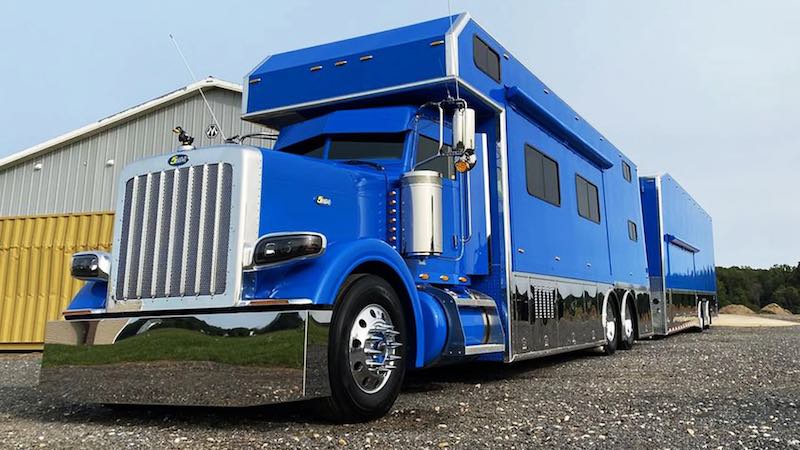Thanks for your support! If you make a purchase using our links in this article, we may make a commission. And, as an Amazon Associate, I earn from qualifying purchases. See the full disclosure here.
What exactly is a toterhome, you may wonder? Is it a semi-truck or a large Class A motorhome? No, wait, it’s a toterhome. It’s a what?
If you’ve ever had one of these beasts pass you on the highway, you certainly did a double-take or two. As your brain determines what it is, it’s already gone, leaving your tiny RV in the dust.
Toterhomes are a unique breed of vehicle that is not easily forgotten. They conjure a sense of curiosity mixed with puzzlement and awe.
They make you wonder what famous person is inside, or if it’s being used for a film set on wheels. Toterhomes are definitely one-of-a-kind. They’re the biggest, baddest RVs on the road, after all.
This article helps clear the mystery and confusion surrounding toterhomes. You’ll learn about the benefits of toterhomes, if they require a special license, what they’re used for, and receive a tour of one.
So, let’s get started and find out all there is to know about toterhomes!
What is a Toterhome?
A toterhome (the term combines the words “tow” and “motorhome”) is a Class A motorhome capable of towing or carrying heavy towables, such as a boat, trailer, or automobile. It’s a hybrid of sorts, with the best features of a semi-tractor truck and an RV.
Think of toterhomes as the mullets of RVs: business in the front, party in the back. Toterhomes have a spacious living space in the back (usually with all the bells and whistles of a luxury RV) with a powerful semi-truck cab upfront to tow or haul whatever your heart desires.
Race car drivers and their teams commonly used toterhomes to transport vehicles and equipment to and from events. They’re also popular with touring bands, entertainment groups, horse racing teams, and other production companies for mobile dressing rooms, equipment storage, and living quarters.
How Big Are Toterhomes?
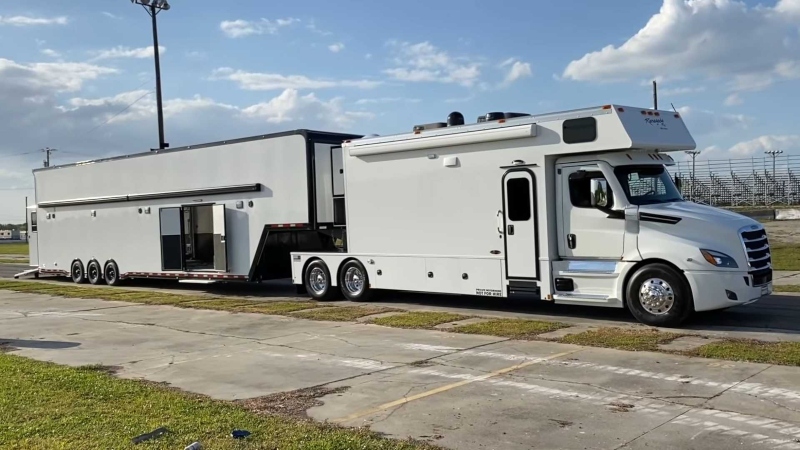
Toterhomes come in different sizes, but they’re all behemoths compared to your average RV. Toterhomes can range anywhere from 25 to 65 feet. The average toterhome is about 36 feet long and 8.5 feet wide, but some are even larger.
Toterhomes are also taller than most RVs, making them difficult to maneuver in tight spaces. However, their size also makes them ideal for teams that require a lot of space.
Toterhomes have room for storage and living. And, because they’re built on a truck chassis, they can tow or haul just about anything you need.
Super C Motorhomes Vs. Toterhomes
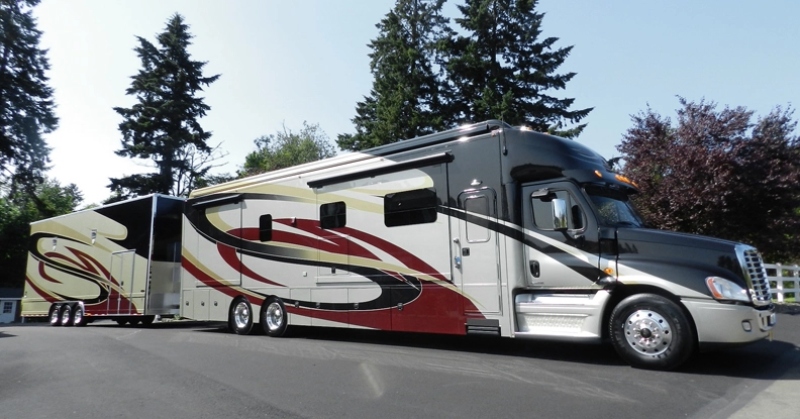
What makes a toterhome different from a Super C motorhome is the overall design decisions between the two. Today, it’s really easy to confuse the two since Super C motorhomes were born from toterhomes.
Super C motorhomes are essentially luxury Class A motorhomes on medium-duty truck chassis. You’ll have a towing capability of around 10,000-15,000 pounds and one of the more popular Cummins L or B series engines.
The goal of a Super C is the payload capacity. The designers will design the interior with the best of everything for the best RV interior experience possible. They’ll even add a suspension system for a smooth ride, and all the fixin’s a luxury Class A RV has to offer.
On the other hand, a toterhome is all about towing. If you have two NASCAR race cars, an arsenal of tools, and all of the other parts and equipment you need in a super-long fifth-wheel storage trailer, you need something to tow it. That’s where a toterhome becomes useful.
If you have 3 days to drive from Indianapolis, Indiana, to Daytona, Florida, with that trailer, that Toterhome will have 2-3 drivers running that toterhome non-stop.
The RV uses a full-size semi-tractor chassis from names like Freightliner, Peterbilt, International, and other brands. Don’t be surprised if you see a Cummins X Series or one of Volvo’s biggest engines.
Off-duty drivers can enjoy the RV features in the coach section like a real bed to sleep in, a full kitchen, an entertainment system, and other amenities. Features can be comfortable camping to luxury level depending on how generous the sponsors are.
What Class is a Toterhome?
Toterhomes are classified as Class A motorhomes. Class A motorhomes are the largest RVs on the road and are built on a truck chassis.
They range in size from 20 to 45 feet, with the average length at 33 feet. Class A motorhomes have all the features of a luxury home on wheels and are great for extended travel or full-time living.
Shorter fifth-wheel-style toterhomes may not have traditional permanent beds. Those with over-cab lofts use that space as a sleeping space. The convertible dinette sleeps usually sleeps two.
Longer versions with a full coach inside that use a chassis-mount ball hitch will have a more traditional RV floorplan that includes a master suite, full kitchens, and living rooms. Depending on the brand, they may also offer bunkhouse motorhome layouts.
Benefits of a Toterhome
Toterhomes are recreational vehicles that combine a motorhome’s living quarters with a semi-truck’s towing capacity. They’re an ideal option for those who enjoy spending time on the open road with many comforts of home.
Full-length toterhomes do have plenty of storage by themselves. Even though a toterhome’s purpose is to haul heavy equipment, you’ll find that their exterior storage has some room for your gear, and the interior has plenty of room for your belongings and food.
Another benefit is that toterhomes offer plenty of space for entertaining. Toterhomes have large living areas, kitchens, and bathrooms. They also often have outdoor living spaces, like patios or decks. This makes them perfect for hosting parties or gatherings on the road.
Last, toterhomes are built on a truck chassis, which means they’re designed for towing. Toterhomes can tow boats, trailers, and other vehicles behind them. This makes them a versatile option for those who like to travel with all their heavy toys.
Who Uses Toterhomes?
With the high price tags, Toterhomes are definitely not for everyone but offer features, power, and a towing capacity that others don’t. Common users are:
- Race car driving teams
- Sports Teams and athletes
- Musical groups and soloists
- Production and marketing groups
- Horse racing teams and ranchers
- Rodeo competitors
Do You Need a Special License to Drive a Toterhome?
A special license is a driver’s license that allows you to drive a specific vehicle according to your domicile state laws. There are two general types of special licenses: commercial and non-commercial.
A commercial driver’s license (CDL) allows individuals to drive vehicles for work purposes. CDLs are most commonly used by truck drivers transporting products to stores across the country.
For our purposes, rock stars and race car drivers hire toterhome drivers to haul their equipment. It also allows you to carry up to sixteen passengers or more, depending on the state law and capacity of the vehicle.
There are two types of commercial licenses: Class A and Class B.
A Class A commercial license is required for a combination of vehicles (i.e., a toterhome connected to a trailer) with a GVWR of 26,001 pounds or more and a towing capacity of over 10,000 pounds.
If your toterhome has a GVWR of 26,001 lbs. or more, but its towing capacity is less than 10,000 lbs, then a Class B license is required.
If you find your domicile state below, pay special attention to what is needed if you plan to purchase a toterhome.
States that Require a Commercial License
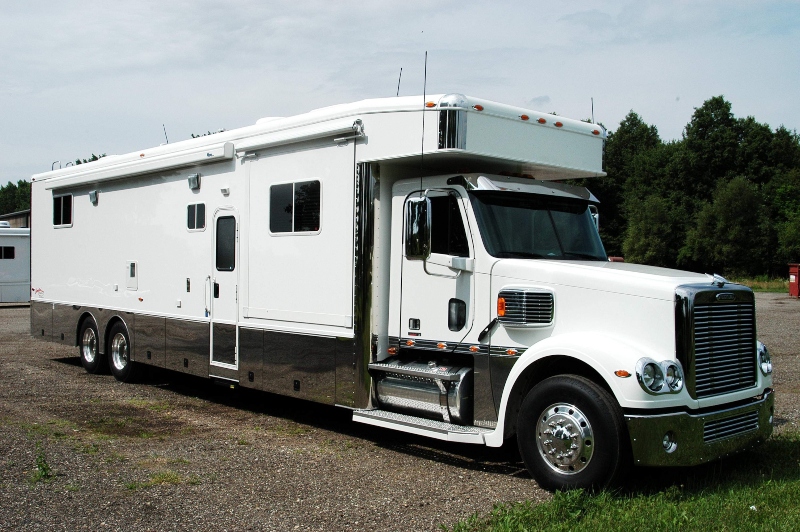
Suppose your toterhome matches the description requirements above for Class A or B. In that case, the following states will require you to obtain a commercial license if you drive a toterhome for work purposes. Please see the links for more details.
States that Require a Non-Commercial License (NCDL)
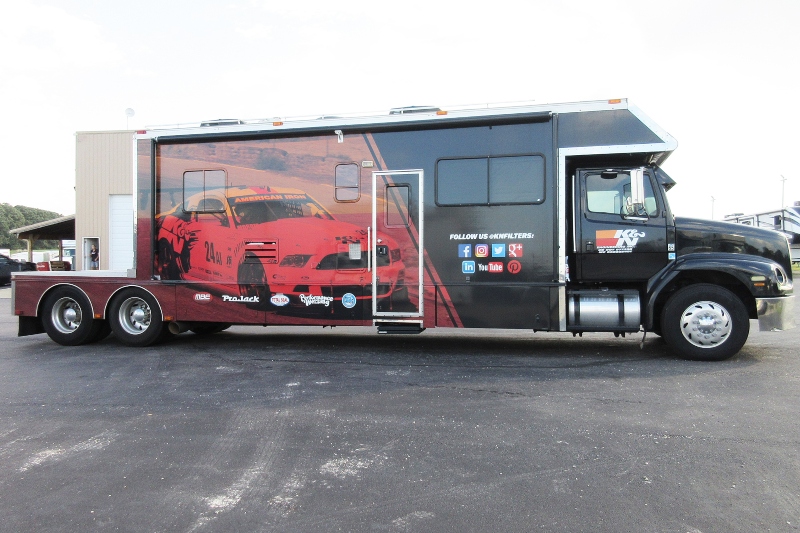
If you don’t drive a toterhome for business, but it matches the weight restrictions for a Class A or B license, the following states require a non-commercial license.
- California
- Hawaii
- Illinois
- Kansas
- Maryland
- Nevada
- New Mexico
- North Carolina
- Pennsylvania
- South Carolina
- Texas
- Wyoming
Because toterhomes are classified as Class A motorhomes, they can be driven with a standard driver’s license within the states that don’t require special licenses.
Regardless of what your state requires, because toterhomes are so large, it’s essential to have experience driving larger vehicles before getting behind the wheel.
Who Manufactures Toterhomes?
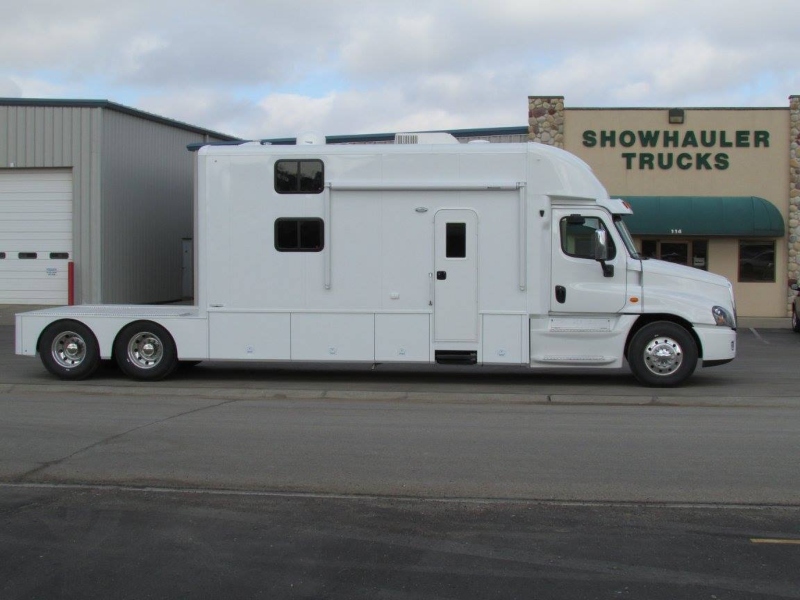
Many toterhomes are custom-built, but several manufacturers produce them. One of the most popular toterhome manufacturers is the REV Group which builds fire trucks, ambulances, buses, and other large vehicles.
In addition, the company’s Renegade RV division produces a line of toterhomes, including the IKON and the Classic.
Another popular manufacturer is ShowHauler Motorhome Conversions, which produces custom and stock toterhomes. The company offers a wide range of floor plans and features to choose from.
Where Can You Buy a Toterhome?
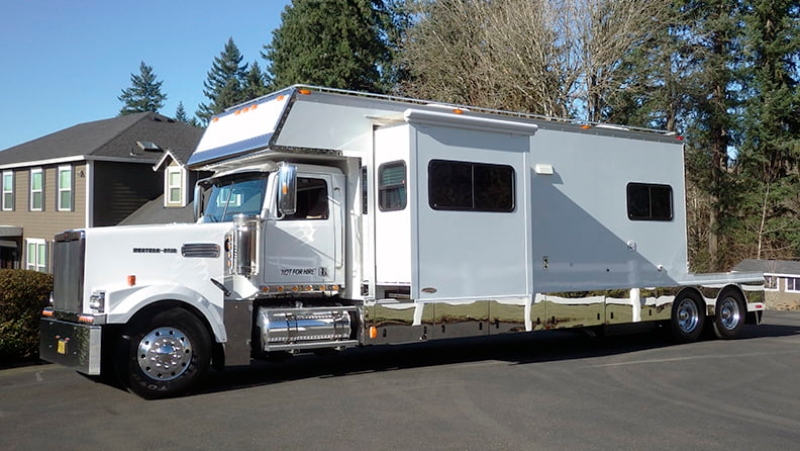
If you’re in the market for a toterhome, there are a few things to keep in mind. First, toterhomes are not like other RVs. They’re specifically designed to haul around large equipment.
They’re often much larger and heavier than your average RV. Finding a toterhome for sale can be a bit of a challenge. Here are a few tips to help you find the toterhome of your dreams:
- Check RV dealerships. Many RV dealerships sell toterhomes, so it’s worth calling them to see if they have any for sale or advise you where to find one.
- Check online classifieds. Several websites are dedicated to selling RVs, and many have toterhomes for sale, such as Racing Junk and RVT.
- Check manufacturer websites. Many toterhome manufacturers have websites where you can find both new and used models for sale.
With a bit of patience and perseverance, you should be able to find the perfect toterhome for your needs.
How Much Does a Toterhome Cost?
Toterhomes vary in size and amenities, typically including a kitchen, bathroom, sleeping area, and living space. As a result, prices for toterhomes can range widely, depending on the size and features of the unit. However, most toterhomes fall in the price range of $250,000 to $500,000.
For those looking for a more luxurious option, a few toterhomes on the market cost well over $500,000. But, conversely, buying used can lower the cost significantly.
Whether you’re looking for a toterhome to live in full-time or one for hauling around your race car, there’s sure to be a toterhome on the market that fits your needs and budget.
Pros and Cons of Toterhomes
Like anything else, toterhomes have their pros and cons. Here are a few things to keep in mind if you’re considering buying a toterhome.
The advantages of owning a toterhome include:
- You can haul around large equipment. Toterhomes are specifically designed to transport large items like race cars, boats, and other heavy equipment.
- They’re self-contained. Toterhomes have all the amenities you need to live comfortably on the road, including a kitchen, bathroom, and sleeping area.
- Toterhomes are classified as Class A motorhomes, meaning they can operate with a standard driver’s license in most states.
- They’re often custom-built, so you can precisely get the features and layout you want.
The disadvantages of owning a toterhome include:
- Toterhomes are typically much more expensive than other types of RVs.
- They’re challenging to find. Toterhomes are not as common as other types of RVs, so they can be difficult to find for sale.
- They’re large and heavy. Toterhomes are larger and heavier than most RVs, making them difficult to drive and park.
- They’re not as fuel-efficient as other RVs. Toterhomes typically get lower gas mileage than other types of RVs.
Be sure to weigh the pros and cons carefully to decide if a toterhome is the right choice for you.
Final Thoughts About Toterhomes
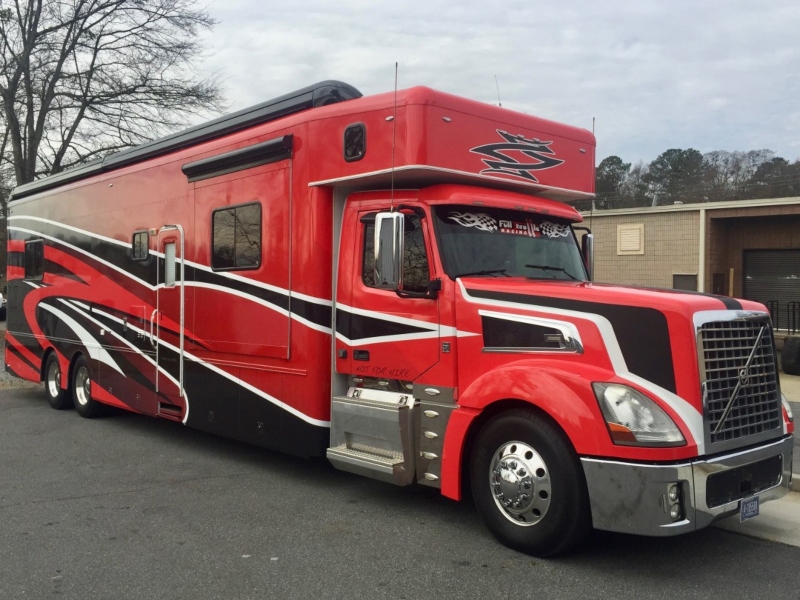
A toterhome is not your standard RV. Instead, it is a vehicle that combines an RV’s living space with a semi-truck’s hauling capacity.
Toterhomes are usually built on a full-size heavy-duty truck chassis. They feature a spacious interior, complete with all the amenities of a home. Toterhomes focus on pulling heavy equipment while Super C motorhomes cater to a luxury interior living experience.
If you are looking for an RV that is spacious and capable of hauling a large amount of cargo, then a toterhome may be the perfect option.

